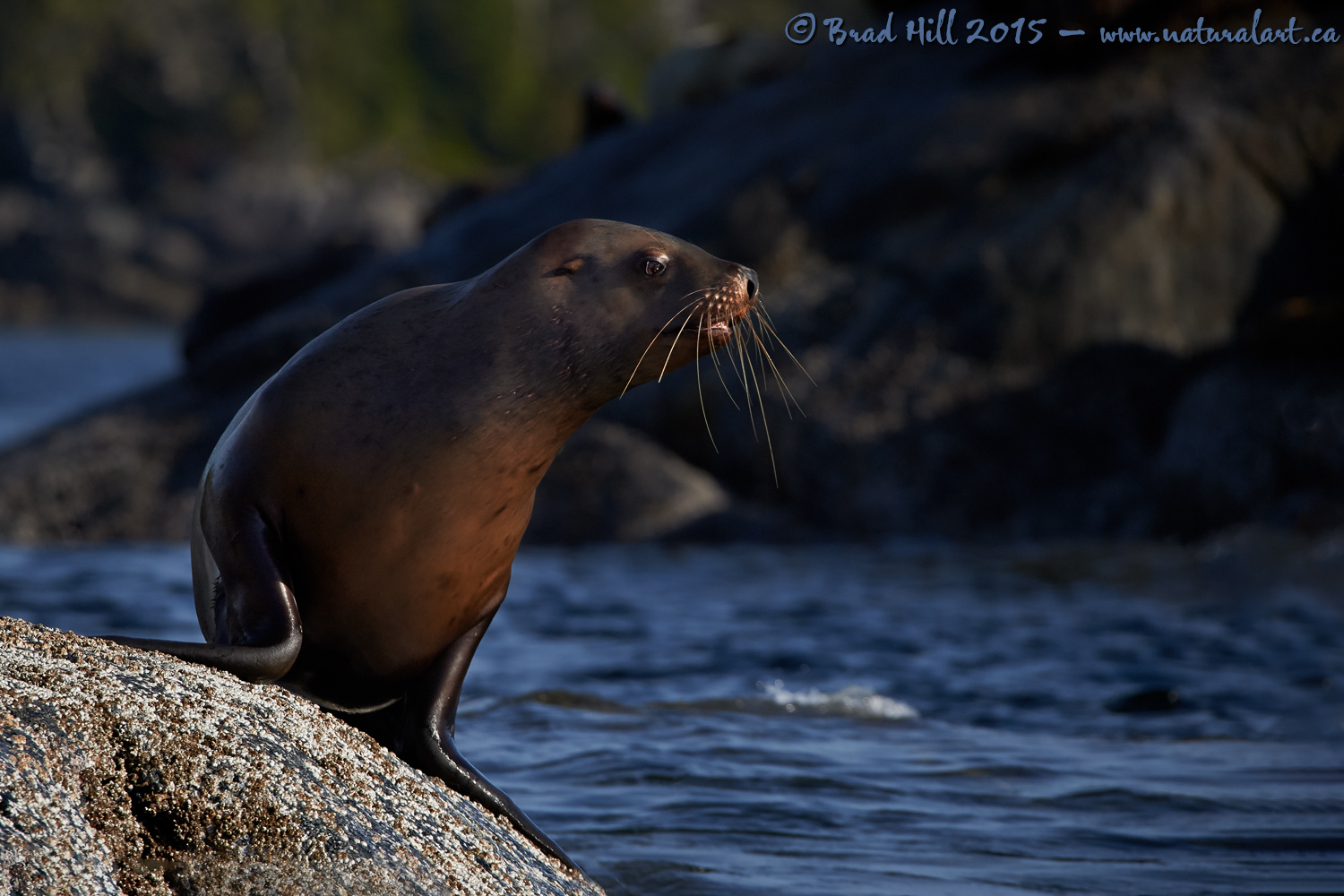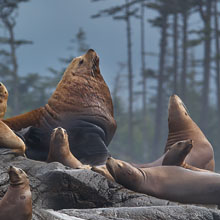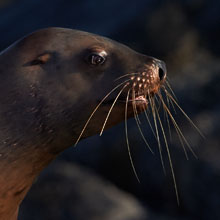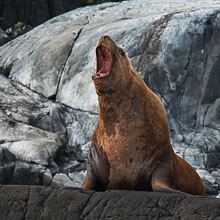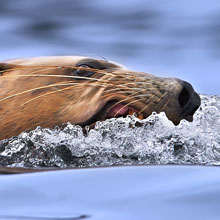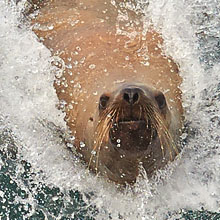Availability: Undetermined - Enquiries?
In the Field
Whiskers! Great Bear Rainforest (central BC coast), BC, Canada. October 5, 2015.
Get up close and personal with a Steller Sea Lion and it's pretty much impossible NOT to be impressed with its crop of whiskers! If you really want those whiskers to stand out, then catching them with strong side-lighting (against a dark background) doesn't hurt at all! Side-lighting is probably my favourite form of direct lighting to work with when photographing wildlife - it can be tricky to handle during image capture (watch out - it's easy to blow out highlights with sidelit subjects!) and image processing (please DON'T overuse the shadow recovery tool!) but it can add great drama to your shots.
Back to those amazing whiskers. The more formal term for them is vibrissae, and they do have a sensory function. Each individual whisker is connected to multiple nerves, and they allow their "owners" to feel their surroundings by picking up tiny vibrations. Sea Lion vibrissae also are hollow, and appear to function as pressure sensors. Interestingly, they are oval in cross section, not round. Recent research has indicated that this oval shape, combined with the orientation they are held when the animal is swimming, helps minimize the vibrations of the whiskers themselves, thus reducing "self-noise" of the whiskers, and helping the animal to better detect important vibrations in the water that are caused by the environment and nearby animals. Cool, eh?
I captured this sea lion image along the portion of the BC coast that is known as the Great Bear Rainforest. Tagging this region with the Great Bear Rainforest name has had many positive conservation consequences, but at the same time it can be easy to forget that there's a whole lot more than bears in "The Great Bear". Besides many other terrestrial animals (from wolves, wolverines, and martens), the waters of the region are chock-full of fascinating creatures, including 5 species of salmon, Humpback Whales, Killer Whales, Steller Sea Lions, Harbour Seals, and more (to name just a few!). It's an absolutely incredible place for any wildlife photographer to visit!
Here's a higher-resolution (2400-pixel) version of mustachioed and slippery sea lion for your perusal and downloading pleasure:
• Whiskers!: Download 2400 pixel image (JPEG: 1.3 MB)
ADDITIONAL NOTES:
NOTE 1: This image - in all resolutions - is protected by copyright. I'm fine with personal uses of it (including use as desktop backgrounds or screensavers on your own computer), but unauthorized commercial use of the image is prohibited by law. Thanks in advance for respecting my copyright!
NOTE 2: Like all wildlife photographs on this website, this image was captured following the strict ethical guidelines described in The Wildlife FIRST! Principles of Photographer Conduct. I encourage all wildlife photographers to always put the welfare of their subjects above the value of their photographs.
NOTE 3: This image was captured during one of my "Into the Great Bear Rainforest" photo tours in the autumn of 2015. Each year I offer trips into two different parts of the Great Bear Rainforest as well as one to photograph aquatic mammals and oceanscapes near the northern tip of Vancouver Island. And, in selected years, I also offer photo tours to locations to capture other highly sought-after subjects, such as various owl species of the boreal forest and wildlife of Canada's Arctic. Details about these trips can be found on the Photo Tours page of this website.
Behind the Camera
Whiskers! Great Bear Rainforest (central BC coast), BC, Canada. October 5, 2015.
Digital Capture; Compressed RAW (NEF) 14-bit format; ISO 1800.
Nikon D4s paired with Sigma Sport 150-600mm zoom lens @ 600mm. Hand-held from bobbing Zodiac. Optical Stabilization on and in "OS1" mode.
1/2000s @ f8; -0.33 stop compensation from "recommended" matrix-metered exposure setting.
At the Computer
Whiskers! Great Bear Rainforest (central BC coast), BC, Canada. October 5, 2015.
RAW Conversion to 16-bit TIFF using Phase One’s Capture One Pro 8. Three raw variants (different versions of a single raw capture) processed, with the variants differing only in exposure (1/0 stop total difference between the variants).
Further digital corrections on resulting 16-bit TIFF files using Adobe's Photoshop CC 2015 and Light Crafts Lightzone. Photoshop adjustments included compositing (blending) of the three output files from the raw converter, minor exposure tweaks, and final selective sharpening for web output. Final tone-tweaking performed using LightZone’s "tonemapper" tool.
Conservation
Whiskers! Great Bear Rainforest (central BC coast), BC, Canada. October 5, 2015.
Ten percent of the revenue generated by this image will be donated to Raincoast*.
Species Status in Canada**: Special Concern (November 2003) - protected in Canada since 1970.
The Steller Sea Lion (Eumetopias jubatus) is the largest of the sea-lions, and males can weigh up to a ton (females are considerably smaller and rarely weigh over 600 lb). Males compete among themselves for females, and successful males end up breeding with several females within their harem.
From the early 1900's through to the 1970's huge numbers of Steller's Sea-Lions were culled for their fur and to remove a competitor (for humans) for salmon. During that time approximately 55,000 sea lions were killed and the breeding population of BC was lowered to about 4,000 animals. Since the Steller Sea Lion first received protection in 1970 the population in the coastal waters of BC has grown to between 18,000 to 19,700 animals (7,600 or so of these are of breeding age).
*The Raincoast Conservation Society (and Foundation) is an effective and efficient organization that has been fighting for protection of this unique habitat. If you are looking for a meaningful way to contribute to the conservation of this amazing ecosystem, Raincoast will provide maximal "bang" for your conservation dollars.
**as determined by COSEWIC: The Committee on the Status of Endangered Wildlife in Canada












